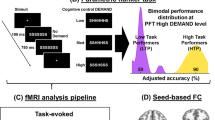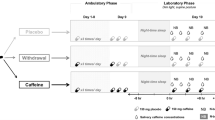Abstract
The val allele of the catechol-O-methyltransferase (COMT) val158met polymorphism has been linked with nicotine dependence and with cognitive performance in healthy volunteers. We tested the hypothesis that the val allele is a risk factor for altered brain function and cognition during nicotine abstinence as compared with the normal smoking state. Chronic smokers (n=33) were genotyped prospectively for the COMT polymorphism for balanced selection of met/met, val/met and val/val groups. A visual N-back working memory task was performed during two separate blood oxygen level-dependent (BOLD) functional magnetic resonance imaging sessions in counterbalanced order: (1) smoking as usual, and (2)⩾14 h confirmed abstinence. Significant genotype by session interactions were observed for BOLD signal in right dorsolateral prefrontal cortex (DLPFC; (P=0.0005), left DLPFC (P=0.02) and dorsal cingulate/medial prefrontal cortex (P=0.01) as well as for task reaction time (P=0.03). Smokers with val/val genotypes were more sensitive to the abstinence challenge than carriers of the met allele, with the greatest effects on BOLD signal and performance speed at the highest working memory load. These data suggest a novel brain–behavior mechanism that may underlie the increased susceptibility to nicotine dependence and smoking relapse associated with the COMT val allele. Exploration of the effects of COMT inhibitors as a possible smoking cessation aid in this group may be warranted.
This is a preview of subscription content, access via your institution
Access options
Subscribe to this journal
Receive 12 print issues and online access
$259.00 per year
only $21.58 per issue
Buy this article
- Purchase on Springer Link
- Instant access to full article PDF
Prices may be subject to local taxes which are calculated during checkout


Similar content being viewed by others
References
Gogos JA, Morgan M, Luine V, Santha M, Ogawa S, Pfaff D et al. Catechol-O-methyltransferase-deficient mice exhibit sexually dimorphic changes in catecholamine levels and behavior. Proc Natl Acad Sci USA 1998; 95: 9991–9996.
Huotari M, Gogos JA, Karayiorgou M, Koponen O, Forsberg M, Raasmaja A et al. Brain catecholamine metabolism in catechol-O-methyltransferase (COMT)-deficient mice. Eur J Neurosci 2002; 15: 246–256.
Chen J, Lipska BK, Halim N, Ma QD, Matsumoto M, Melhem S et al. Functional analysis of genetic variation in catechol-O-methyltransferase (COMT): effects on mRNA, protein, and enzyme activity in postmortem human brain. Am J Hum Genet 2004; 75: 807–821.
Lachman H, Papolos DF, Saito T, Yu YM, Szumlanski CL, Weinshilboum RM . Human catechol-O-methyltransferase pharmacogenetics: description of a functional polymorphism and its potential application to neuropsychiatric disorders. Pharmacogenetics 1996; 6: 243–250.
Lotta T, Vidgren J, Tilgmann C, Ulmanen I, Melén K, Julkunen I et al. Kinetics of human soluble and membrane-bound catechol O-methyltransferase: a revised mechanism and description of the thermolabile variant of the enzyme. Biochemistry 1995; 34: 4202–4210.
Nestler EJ . Is there a common molecular pathway for addiction? Nat Neurosci 2005; 8: 1445–1449.
Colilla S, Lerman C, Shields PG, Jepson C, Rukstalis M, Berlin J et al. Association of catechol-O-methyltransferase with smoking cessation in two independent studies of women. Pharmacogenet Genomics 2005; 15: 393–398.
Johnstone EC, Elliot KM, David SP, Murphy MF, Walton RT, Munafò MR . Association of COMT Val108/158Met genotype with smoking cessation in a nicotine replacement therapy randomized trial. Cancer Epidemiol Biomarkers Prev 2007; 16: 1065–1069.
Munafo MR, Johnstone EC, Guo B, Murphy MF, Aveyard P . Association of COMT Val108/158Met genotype with smoking cessation. Pharmacogenet Genomics 2008; 18: 121–128.
Barnett JH, Jones PB, Robbins TW, Muller U . Effects of the catechol-O-methyltransferase Val158Met polymorphism on executive function: a meta-analysis of the Wisconsin Card Sort Test in schizophrenia and healthy controls. Mol Psychiatry 2007; 12: 502–509.
Bertolino A, Blasi G, Latorre V, Rubino V, Rampino A, Sinibaldi L et al. Additive effects of genetic variation in dopamine regulating genes on working memory cortical activity in human brain. J Neurosci 2006; 26: 3918–3922.
Caldu X, Vendrell P, Bartrés-Faz D, Clemente I, Bargalló N, Jurado MA et al. Impact of the COMT Val108/158 Met and DAT genotypes on prefrontal function in healthy subjects. Neuroimage 2007; 37: 1437–1444.
Egan MF, Goldberg TE, Kolachana BS, Callicott JH, Mazzanti CM, Straub RE et al. Effect of COMT Val108/158 Met genotype on frontal lobe function and risk for schizophrenia. Proc Natl Acad Sci USA 2001; 98: 6917–6922.
McIntosh AM, Baig BJ, Hall J, Job D, Whalley HC, Lymer GK et al. Relationship of catechol-O-methyltransferase variants to brain structure and function in a population at high risk of psychosis. Biol Psychiatry 2007; 61: 1127–1134.
Meyer-Lindenberg A, Nichols T, Callicott JH, Ding J, Kolachana B, Buckholtz J et al. Impact of complex genetic variation in COMT on human brain function. Mol Psychiatry 2006; 11: 867–877, 797.
Winterer G, Musso F, Vucurevic G, Stoeter P, Konrad A, Seker B et al. COMT genotype predicts BOLD signal and noise characteristics in prefrontal circuits. Neuroimage 2006; 32: 1722–1732.
Davis JA, James JR, Siegel SJ, Gould TJ . Withdrawal from chronic nicotine administration impairs contextual fear conditioning in C57BL/6 mice. J Neurosci 2005; 25: 8708–8713.
Domier CP, Monterosso JR, Brody AL, Simon SL, Mendrek A, Olmstead R et al. Effects of cigarette smoking and abstinence on Stroop task performance. Psychopharmacology 2007; 195: 1–9.
Semenova S, Stolerman IP, Markou A . Chronic nicotine administration improves attention while nicotine withdrawal induces performance deficits in the 5-choice serial reaction time task in rats. Pharmacol Biochem Behav 2007; 87: 360–368.
Krishnan-Sarin S, Reynolds B, Duhig AM, Smith A, Liss T, McFetridge A et al. Behavioral impulsivity predicts treatment outcome in a smoking cessation program for adolescent smokers. Drug Alcohol Depend 2007; 88: 79–82.
Rukstalis M, Jepson C, Patterson F, Lerman C . Increases in hyperactive-impulsive symptoms predict relapse among smokers in nicotine replacement therapy. J Subst Abuse Treat 2005; 28: 297–304.
Owen AM, McMillan KM, Laird AR, Bullmore E . N-back working memory paradigm: a meta-analysis of normative functional neuroimaging studies. Hum Brain Mapp 2005; 25: 46–59.
Pomerleau CS, Carton SM, Lutzke ML, Flessland KA, Pomerleau OF . Reliability of the Fagerstrom Tolerance Questionnaire and the Fagerstrom Test for Nicotine Dependence. Addict Behav 1994; 19: 33–39.
McClernon FJ, Hiott FB, Huettel SA, Rose JE . Abstinence-induced changes in self-report craving correlate with event-related FMRI responses to smoking cues. Neuropsychopharmacology 2005; 30: 1940–1947.
Hughes JR, Hatsukami DK, Pickens RW, Krahn D, Malin S, Luknic A . Effect of nicotine on the tobacco withdrawal syndrome. Psychopharmacology 1984; 83: 82–87.
Tiffany ST, Drobes DJ . The development and initial validation of a questionnaire on smoking urges. Br J Addict 1991; 86: 1467–1476.
Braver TS, Cohen JD, Nystrom LE, Jonides J, Smith EE, Noll DC . A parametric study of prefrontal cortex involvement in human working memory. Neuroimage 1997; 5: 49–62.
Ragland JD, Turetsky BI, Gur RC, Gunning-Dixon F, Turner T, Schroeder L et al. Working memory for complex figures: an fMRI comparison of letter and fractal n-back tasks. Neuropsychology 2002; 16: 370–379.
Jacobsen LK, Krystal JH, Mencl WE, Westerveld M, Frost SJ, Pugh KR . Effects of smoking and smoking abstinence on cognition in adolescent tobacco smokers. Biol Psychiatry 2005; 57: 56–66.
Mendrek A, Monterosso J, Simon SL, Jarvik M, Brody A, Olmstead R et al. Working memory in cigarette smokers: comparison to non-smokers and effects of abstinence. Addict Behav 2006; 31: 833–844.
Talairach J, Tournoux P . Co-planer Stereotaxic Atlas of the Human Brain. Thieme Medical Publishers: New York, NY, 1988.
Woolrich MW, Ripley BD, Brady M, Smith SM . Temporal autocorrelation in univariate linear modeling of FMRI data. Neuroimage 2001; 14: 1370–1386.
Lancaster JL, Woldorff MG, Parsons LM, Liotti M, Freitas CS, Rainey L et al. Automated Talairach atlas labels for functional brain mapping. Hum Brain Mapp 2000; 10: 120–131.
Van Essen DC, Drury HA, Dickson J, Harwell J, Hanlon D, Anderson CH . An integrated software suite for surface-based analyses of cerebral cortex. J Am Med Inform Assoc 2001; 8: 443–459.
Barnett JH, Scoriels L, Munafo MR . Meta-analysis of the cognitive effects of the catechol-O-methyltransferase gene Val158/108Met polymorphism. Biol Psychiatry 2008; 64: 137–144.
Diaz-Asper CM, Goldberg TE, Kolachana BS, Straub RE, Egan MF, Weinberger DR . Genetic variation in catechol-O-methyltransferase: effects on working memory in schizophrenic patients, their siblings, and healthy controls. Biol Psychiatry 2008; 63: 72–79.
Goldberg TE, Egan MF, Gscheidle T, Coppola R, Weickert T, Kolachana BS et al. Executive subprocesses in working memory: relationship to catechol-O-methyltransferase Val158Met genotype and schizophrenia. Arch Gen Psychiatry 2003; 60: 889–896.
Beuten J, Payne TJ, Ma JZ, Li MD . Significant association of catechol-O-methyltransferase (COMT) haplotypes with nicotine dependence in male and female smokers of two ethnic populations. Neuropsychopharmacology 2006; 31: 675–684.
Xu J, Mendrek A, Cohen MS, Monterosso J, Rodriguez P, Simon SL et al. Brain activity in cigarette smokers performing a working memory task: effect of smoking abstinence. Biol Psychiatry 2005; 58: 143–150.
Ernst M, Matochik JA, Heishman SJ, Van Horn JD, Jons PH, Henningfield JE et al. Effect of nicotine on brain activation during performance of a working memory task. Proc Natl Acad Sci USA 2001; 98: 4728–4733.
Yavich L, Forsberg MM, Karayiorgou M, Gogos JA, Mannisto PT . Site-specific role of catechol-O-methyltransferase in dopamine overflow within prefrontal cortex and dorsal striatum. J Neurosci 2007; 27: 10196–10209.
Brody AL, Mandelkern MA, Olmstead RE, Scheibal D, Hahn E, Shiraga S et al. Gene variants of brain dopamine pathways and smoking-induced dopamine release in the ventral caudate/nucleus accumbens. Arch Gen Psychiatry 2006; 63: 808–816.
Lerman C, LeSage MG, Perkins KA, O’Malley SS, Siegel SJ, Benowitz NL et al. Translational research in medication development for nicotine dependence. Nat Rev Drug Discov 2007; 6: 746–762.
Gasparini M, Fabrizio E, Bonifati V, Meco G . Cognitive improvement during Tolcapone treatment in Parkinson's disease. J Neural Transm 1997; 104: 887–894.
Apud JA, Mattay V, Chen J, Kolachana BS, Callicott JH, Rasetti R et al. Tolcapone improves cognition and cortical information processing in normal human subjects. Neuropsychopharmacology 2007; 32: 1011–1020.
Yacubian J, Sommer T, Schroeder K, Gläscher J, Kalisch R, Leuenberger B et al. Gene–gene interaction associated with neural reward sensitivity. Proc Natl Acad Sci USA 2007; 104: 8125–8130.
Jacobsen LK, Pugh KR, Mencl WE, Gelernter J . C957T polymorphism of the dopamine D2 receptor gene modulates the effect of nicotine on working memory performance and cortical processing efficiency. Psychopharmacology 2006; 188: 530–540.
Nackley AG, Shabalina SA, Tchivileva IE, Satterfield K, Korchynskyi O, Makarov SS et al. Human catechol-O-methyltransferase haplotypes modulate protein expression by altering mRNA secondary structure. Science 2006; 314: 1930–1933.
Palmatier MA, Kang AM, Kidd KK . Global variation in the frequencies of functionally different catechol-O-methyltransferase alleles. Biol Psychiatry 1999; 46: 557–567.
Acknowledgements
This research was supported by grants from the National Cancer Institute and National Institutes on Drug Abuse (P50CA/DA84718), NIH/NINDS Neuroscience Neuroimaging Center (P30 NS045839) and the Pennsylvania Department of Health. The Department of Health disclaims responsibility for any analyses, interpretations or conclusions.
Author information
Authors and Affiliations
Corresponding authors
Additional information
Disclosure/conflict of interest
The authors do not have any conflicts of interest pertaining to this research.
Supplementary Information accompanies the paper on the Molecular Psychiatry website (http://www.nature.com/mp)
Supplementary information
Rights and permissions
About this article
Cite this article
Loughead, J., Wileyto, E., Valdez, J. et al. Effect of abstinence challenge on brain function and cognition in smokers differs by COMT genotype. Mol Psychiatry 14, 820–826 (2009). https://doi.org/10.1038/mp.2008.132
Received:
Accepted:
Published:
Issue Date:
DOI: https://doi.org/10.1038/mp.2008.132
Keywords
This article is cited by
-
Catechol-O-Methyltransferase Effects on Smoking: a Review and Proof of Concept of Sex-Sensitive Effects
Current Behavioral Neuroscience Reports (2022)
-
Impact of Tryptophan Depletion on Executive System Function during Menopause is Moderated by Childhood Adversity
Neuropsychopharmacology (2017)
-
Using Genetics to Improve Addiction Treatment Outcomes
Current Behavioral Neuroscience Reports (2017)
-
Measuring Cigarette Smoking-Induced Cortical Dopamine Release: A [11C]FLB-457 PET Study
Neuropsychopharmacology (2015)
-
Double dissociation of working memory and attentional processes in smokers and non-smokers with and without nicotine
Psychopharmacology (2015)



